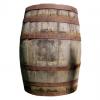So, my current implementation looks like this:
I've got a Quad class which contains a vertex and an index buffer as well as an SRV for the texture and is initialized based on the desired position and size:
using System;
using SharpDX;
using SharpDX.Direct3D11;
using SharpDX.DXGI;
using Buffer = SharpDX.Direct3D11.Buffer;
using Device = SharpDX.Direct3D11.Device;
namespace DX11Renderer.Graphics
{
public class Quad : IDisposable
{
public Buffer VertexBuffer;
public Buffer IndexBuffer;
public ShaderResourceView Texture;
public InputLayout Layout;
public Quad(Device device, byte[] signature, Vector2 position, Vector2 size)
{
var vertices = new[]
{
new Vector4(position, 0, 1),
new Vector4(position.X + size.X, position.Y, 0, 1),
new Vector4(position + size, 0, 1),
new Vector4(position.X, position.Y + size.Y, 0, 1)
};
var uvs = new[]
{
new Vector2(0),
new Vector2(0, 1),
new Vector2(1, 1),
new Vector2(1, 0)
};
var indices = new[]
{0, 1, 2, 2, 3, 0};
var vertexStream = new DataStream((Utilities.SizeOf<Vector4>() + Utilities.SizeOf<Vector2>()) * 4, true, true);
var indexStream = new DataStream(sizeof(int)*6, true, true);
for (int i = 0; i < 4; i++)
{
vertexStream.Write(vertices[i]);
vertexStream.Write(uvs[i]);
}
for (int i = 0; i < 6; i++)
{
indexStream.Write(indices[i]);
}
VertexBuffer = new Buffer(device, vertexStream, new BufferDescription(Utilities.SizeOf<Vector4>()*4 + Utilities.SizeOf<Vector2>() * 4,
ResourceUsage.Default, BindFlags.VertexBuffer, CpuAccessFlags.None, ResourceOptionFlags.None, 0));
IndexBuffer = new Buffer(device, indexStream, new BufferDescription(sizeof(int) * 6,
ResourceUsage.Default, BindFlags.IndexBuffer, CpuAccessFlags.None, ResourceOptionFlags.None, 0));
Layout = new InputLayout(device, signature, new[]
{
new InputElement("POSITION", 0, Format.R32G32B32A32_Float, 0, 0),
new InputElement("TEXCOORD", 0, Format.R32G32_Float, 16, 0)
});
}
public void Dispose()
{
VertexBuffer.Dispose();
IndexBuffer.Dispose();
}
}
}
I create a Quad e.g. in my UIElementButton class like this:
_buttonQuad = new Quad(GameServices.GetService<RendererD3D11>().D3DDevice,
GameServices.GetService<RendererD3D11>().Shaders["QuadShader"].Signature,
Vector2.Zero,
new Vector2(256, 64));
_buttonQuad.Texture = ShaderResourceView.FromFile(GameServices.GetService<RendererD3D11>().D3DDevice, @"Content\Interface\Menu\Button.dds");
Which is then send to the DrawQuad method in the QuadRenderer class:
public void DrawQuad(Quad quad, Shader shader, Device d3DDevice)
{
_context.VertexShader.SetConstantBuffer(0, _cBuffer);
_context.UpdateSubresource(ref _transform, _cBuffer);
_context.InputAssembler.PrimitiveTopology = PrimitiveTopology.TriangleList;
_context.InputAssembler.SetVertexBuffers(0, new VertexBufferBinding(quad.VertexBuffer, 24, 0));
_context.InputAssembler.SetIndexBuffer(quad.IndexBuffer, Format.R32_UInt, 0);
_context.InputAssembler.InputLayout = quad.Layout;
_context.VertexShader.Set(shader.VertexShader);
_context.PixelShader.Set(shader.PixelShader);
_context.PixelShader.SetSampler(0, _sampler);
_context.PixelShader.SetShaderResource(0, quad.Texture);
_context.OutputMerger.SetDepthStencilState(_state);
_context.DrawIndexed(6, 0, 0);
}
FYI, Sampler is AnisotropicWrap and DepthStencilState is Disabled
The data is then to be rendered on the GPU using this simple Shader:
cbuffer QuadBuffer: register(b0)
{
float4x4 projection;
}
Texture2D Texture;
SamplerState textureSampler;
struct VSQuadIn
{
float4 position: POSITION;
float2 texcoord: TEXCOORD;
};
struct VSQuadOut{
float4 position : SV_Position;
float2 texcoord: TexCoord;
};
VSQuadOut VertexShaderFunction(VSQuadIn In)
{
VSQuadOut Out;
Out.texcoord = In.texcoord;
Out.position = mul(In.position, projection);
return Out;
}
float4 PixelShaderFunction(VSQuadOut input) : SV_TARGET
{
float4 textureColor = Texture.Sample(textureSampler, input.texcoord);
textureColor.a = 1;
return textureColor;
}
technique fsQuad
{
pass Pass1
{
VertexShader = compile vs_4_0 VertexShaderFunction();
PixelShader = compile ps_4_0 PixelShaderFunction();
}
};
-------
But when I run the game the Quads don't render and when I take a look using the graphics debugger there's nothing showing up on the Input Assembler and VertexShader stages at all







